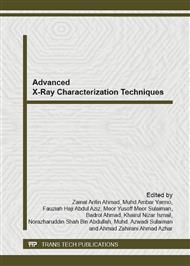[1]
T. Tani, L. Madler and S.E. Pratsinis: Journal of Nanoparticle Research Vol. 4 (2002), p.337–343.
Google Scholar
[2]
S. Music, S. Popovic, M. Maljkovic and Dragcˇevic: Journal of Alloys and Compounds Vol. 347 (2002), p.324–332.
Google Scholar
[3]
P. Singh, A. Kumar, A. Kaushal, D. Kaur, A. Pandey and R.N. Goyal: Bull. Mater. Sci Vol. 31 (2008), p.573–577.
Google Scholar
[4]
M. Copuroglu, L.H.K. Koh, S. O'Brien and G.M. Crean: J Sol-Gel Sci Technol Vol. 52 (2009), p.432–438.
Google Scholar
[5]
Z. Lamia: Materials Science and Engineering: B Vol. 174 (2010), pp.18-30.
Google Scholar
[6]
S.A. Kamaruddin, M.Z. Sahdan, K.Y. Chan, H.K. Yow, J. Krishnasamy, M. Rusop and H. Saim, Influence of immerse time on the properties of Zinc Oxide nanostructures, (2010).
DOI: 10.1109/icp.2010.5604404
Google Scholar
[7]
Z. Khusaimi, Synthesis and Characterisation of Low-Dimensional Zinc Oxide Nanostructures by Solution-Immersion and Mist-Atomisation Faculty of Applied Sciences Universiti Teknologi MARA, Selangor, Malaysia, (2012).
DOI: 10.13052/jiems2446-1822.2016.007
Google Scholar
[8]
S. -Y. Pung, K. -L. Choy and X. Hou: Journal of Crystal Growth Vol. 312 (2010), p.2049-(2055).
Google Scholar
[9]
Z. Khusaimi, M.H. Mamat, M.Z. Sahdan, N. Abdullah and M. Rusop: Defect and Diffusion Forum Vol. 312-315 (2011), pp.104-109.
DOI: 10.4028/www.scientific.net/ddf.312-315.104
Google Scholar
[10]
A.A. Azira, Z. Khusaimi, N.F.A. Zainal, S.F. Nik, T. Soga, S. Abdullah and M. Rusop: Solid State Science and Technology Vol. 17 (2009), pp.140-147.
Google Scholar
[11]
C. Andreazza-Vignolle, P. Andreazza and D. Zhao: Superlattices and Microstructures Vol. 39 (2006), pp.340-347.
DOI: 10.1016/j.spmi.2005.08.060
Google Scholar
[12]
R. Elilarassi and G. Chandrasekaran: Materials Science in Semiconductor Processing Vol. 14 (2011), pp.179-183.
Google Scholar
[13]
N. Shakti and P.S. Gupta: Applied Physics Research Vol. 2 (2010), p.
Google Scholar
[14]
F.I. Ezema and U.O.A. Nwankwo: Journal Of Optoelectronics and Biomedical Materials Vol. 1 (2010), pp.167-173.
Google Scholar
[15]
A. George, S.K. Sharma, S. Chawla, M.M. Malik and M.S. Qureshi: Journal of Alloys and Compounds Vol. In Press, Corrected Proof (2011), p.
Google Scholar
[16]
A. Lei, B. Qu, W. Zhou, Y. Wang, Q. Zhang and B. Zou: Materials Letters Vol. 66 (2012), pp.72-75.
Google Scholar
[17]
X. Wang, Q. Zhang, B. Zou, A. Lei and P. Ren: Applied Surface Science Vol. 257 (2011), pp.10898-10902.
Google Scholar
[18]
H. Zhang, Y. Li, G. Hu, B. Gao and Y. Zhu: J Mater Sci: Mater Electron Vol. 21 (2010), pp.1164-1167.
Google Scholar
[19]
N.K. Singh, S. Shrivastava, S. Rath and S. Annapoorni: Applied Surface Science Vol. 257 (2010), pp.1544-1549.
Google Scholar


